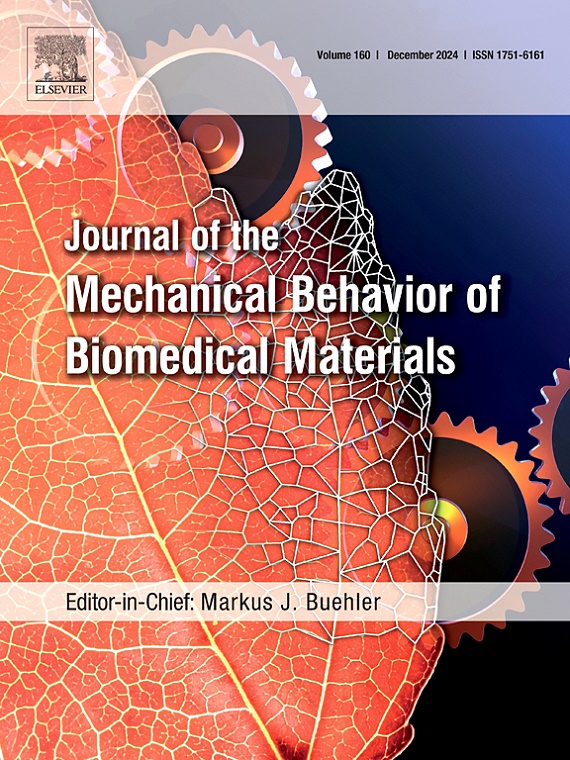Intervertebral disc degeneration increases surface strain on metastatic vertebrae in compression and flexion but not in torsion
IF 3.3
2区 医学
Q2 ENGINEERING, BIOMEDICAL
Journal of the Mechanical Behavior of Biomedical Materials
Pub Date : 2025-06-21
DOI:10.1016/j.jmbbm.2025.107109
引用次数: 0
Abstract
Despite the fundamental role of intervertebral discs (IVDs) in the biomechanics of the spine, their condition has never been considered among the possible factors affecting the mechanical behaviour of metastatic vertebrae. The structure of the IVDs changes over the course of life, leading to alterations of their biomechanical behaviour. This study aimed to assess if IVD degeneration affects the strains experienced by the adjacent healthy or metastatic vertebrae.
Eight human spine segments consisting of four vertebrae, with a healthy and a metastatic vertebra in the middle and mildly degenerated IVD, were prepared. The segments were biomechanically tested under different loading configurations: axial compression, flexion, and torsion. An enzymatic IVD degeneration was induced by injecting a collagenase solution. The degenerated specimens were tested again, following the same loading protocol. Surface vertebral strains were measured with a 3D-Digital Image Correlation (DIC).
IVD degeneration was found to influence the strain distributions in the adjacent vertebrae. In particular, IVD degeneration resulted in a significant increase of the median compressive strains experienced by the cortical shell of the metastatic vertebrae, in both axial compression (+25.6 %) and flexion (+43.7 %), with larger strains close to the degenerated IVD. Conversely, control vertebral showed less relevant variations between the two conditions. Negligible strain differences were, instead, observed in torsion, for both metastatic and control vertebrae.
This study showed the ability of the healthy vertebrae to withstand loads transmitted in different directions and highlighted the susceptibility of metastatic vertebrae to even minor alterations in boundary conditions.

椎间盘退变增加转移性椎体压缩和屈曲时的表面应变,而不是扭转时的表面应变
尽管椎间盘在脊柱的生物力学中起着基本的作用,但它们的状况从未被认为是影响转移性椎体力学行为的可能因素之一。ivd的结构在生命过程中会发生变化,导致其生物力学行为的改变。本研究旨在评估IVD变性是否影响相邻健康或转移椎体所经历的菌株。准备了8个由4个椎骨组成的人体脊柱节段,其中一个是健康的,一个是中度和轻度退行性IVD的转移椎体。在不同的载荷配置下对节段进行生物力学测试:轴向压缩、屈曲和扭转。注射胶原酶溶液诱导酶促IVD变性。退化的标本再次测试,遵循相同的加载方案。采用三维数字图像相关(DIC)测量椎体表面应变。发现IVD退变影响邻近椎体的应变分布。特别是,IVD退变导致转移椎体皮质壳的中位压缩应变显著增加,轴向压缩(+ 25.6%)和屈曲(+ 43.7%),更大的应变接近退变的IVD。相反,对照椎体在两种情况下表现出较少的相关变化。相反,在转移椎体和对照椎体的扭转中观察到的应变差异可以忽略不计。该研究显示了健康椎骨承受不同方向传递载荷的能力,并强调了转移性椎骨对边界条件微小变化的易感性。
本文章由计算机程序翻译,如有差异,请以英文原文为准。
求助全文
约1分钟内获得全文
求助全文
来源期刊

Journal of the Mechanical Behavior of Biomedical Materials
工程技术-材料科学:生物材料
CiteScore
7.20
自引率
7.70%
发文量
505
审稿时长
46 days
期刊介绍:
The Journal of the Mechanical Behavior of Biomedical Materials is concerned with the mechanical deformation, damage and failure under applied forces, of biological material (at the tissue, cellular and molecular levels) and of biomaterials, i.e. those materials which are designed to mimic or replace biological materials.
The primary focus of the journal is the synthesis of materials science, biology, and medical and dental science. Reports of fundamental scientific investigations are welcome, as are articles concerned with the practical application of materials in medical devices. Both experimental and theoretical work is of interest; theoretical papers will normally include comparison of predictions with experimental data, though we recognize that this may not always be appropriate. The journal also publishes technical notes concerned with emerging experimental or theoretical techniques, letters to the editor and, by invitation, review articles and papers describing existing techniques for the benefit of an interdisciplinary readership.
 求助内容:
求助内容: 应助结果提醒方式:
应助结果提醒方式:


